Magpie
lab constructor
    
Posts: 5939
Registered: 1-11-2003
Location: USA
Member Is Offline
Mood: Chemistry: the subtle science.
|
|
Preparation of Malonic Acid
Preparation of Malonic Acid
by Magpie
12/12/09
Introduction
This procedure is for the preparation of ~10 grams of malonic acid via the oxidation of 1,3-propanediol (PDO) using nitric acid.
The predominant reaction appears to be:

CAUTION
This synthesis generates NO which immediately oxidizes to NO2 upon contact with air. NO2 is toxic and therefore this procedure must be done outside
or in an efficient fume hood.
The reaction is highly exothermic and can result in a runaway if not carefully controlled. Adequate personal protective equipment, including thick
rubber gloves and safety goggles, is strongly advised.
Procedure
A. Reagents Preparation
Place 100 mL of water in a beaker and stir in 66.8 mL of 68% nitric acid (1 mole). This will be 6M. Set aside.
Measure out 14.4 mL of PDO (0.2 mole) in a graduated cylinder and set aside.
B. Equipment Set-Up
Set up a 500 mL round bottomed flask (RBF) with a Claisen adapter and a reflux column using a ringstand with wire mesh pad. The reflux column is
attached to the short neck of the Claisen adapter. Using a 2nd ringstand attach a small pressure-equalizing funnel to the long neck of the Claisen
adapter. Provide as much space as possible under the RBF for heating with a Bunsen burner. All fittings are to be ground-glass, coated with a thin
film of silicone grease, and clamped.
Have a Bunsen burner available for heating the RBF. Provide ice-water cooling to the reflux column.
C. Reaction with Reflux
Temporarily remove the reflux column. Using a funnel placed in the Claisen neck, add the nitric acid prepared above to the RBF. Reconnect the reflux
column.
Pour the PDO prepared above into the pressure equalizing funnel (valve closed!). Install the plug in the funnel fill port.
Turn on the iced cooling water to the reflux column. Light the Bunsen burner and set at low heat.
Add ten drops of PDO to the RBF via the pressure equalizing funnel. Steadily but gently heat the RBF until the PDO is actively reacting. Extinguish
the Bunsen burner. When the reaction subsides add another 10 drops of PDO. Continue to add the PDO in this manner, 10 drops at a time. This will
keep the reaction under good control yet still keep the mix hot enough to support the reaction. The RBF will be so hot that you cannot touch the
bottom: an estimated 80°C. NO will be steadily generated and oxidized to NO2 as it comes in contact with air at the top of the column. Watch the
column to assure that nitric acid vaporization is not overwhelming the condenser. If it is, back off on the addition rate of PDO as required.
D. Workup
Pour the product solution into an evaporating dish. Place the dish on a steam bath and evaporate nearly all of the water and residual nitric acid.
This will take about 2 hours. As the mother liquor is concentrated it will eventually turn brown, releasing puffs of NO2. When NO2 evolution has
stopped a white syrupy mix of malonic acid crystals will remain. At this point it will become difficult to remove the remaining liquid from the
crystals using a steam bath. Therefore, transfer the evaporating dish to a drying oven set at ~100°C and dry overnight. Be aware that malonic acid
will decompose to acetic acid and CO2 above 135°C.
Product
There should be ~10g of relatively pure malonic acid for a yield of ~50%. Purity can be checked by determining the melting point, reported by one
source as 135.6°C.
Reference
This procedure is based on the preparation of oxalic acid found in “Some Improved Procedures for the Elementary Organic Laboratory,” by Seymour in
Journal of Chemical Education, June 1939, pp 285-287.
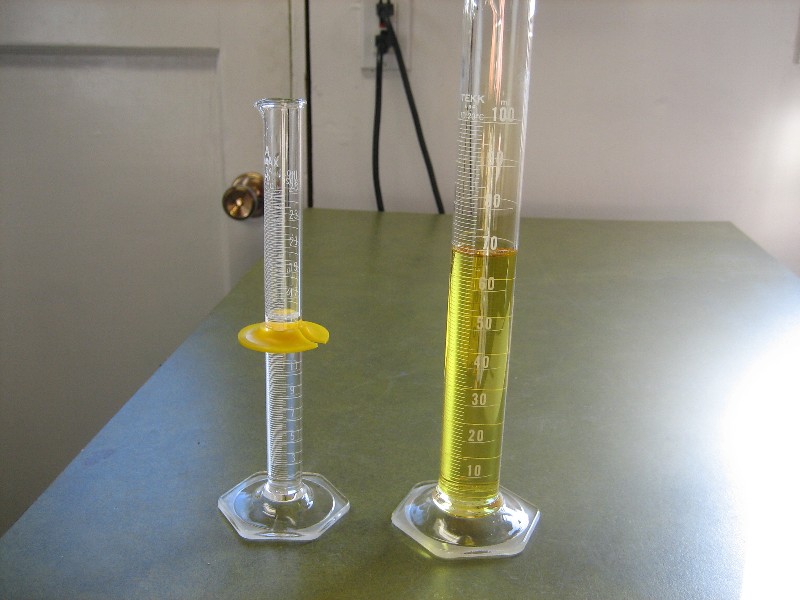 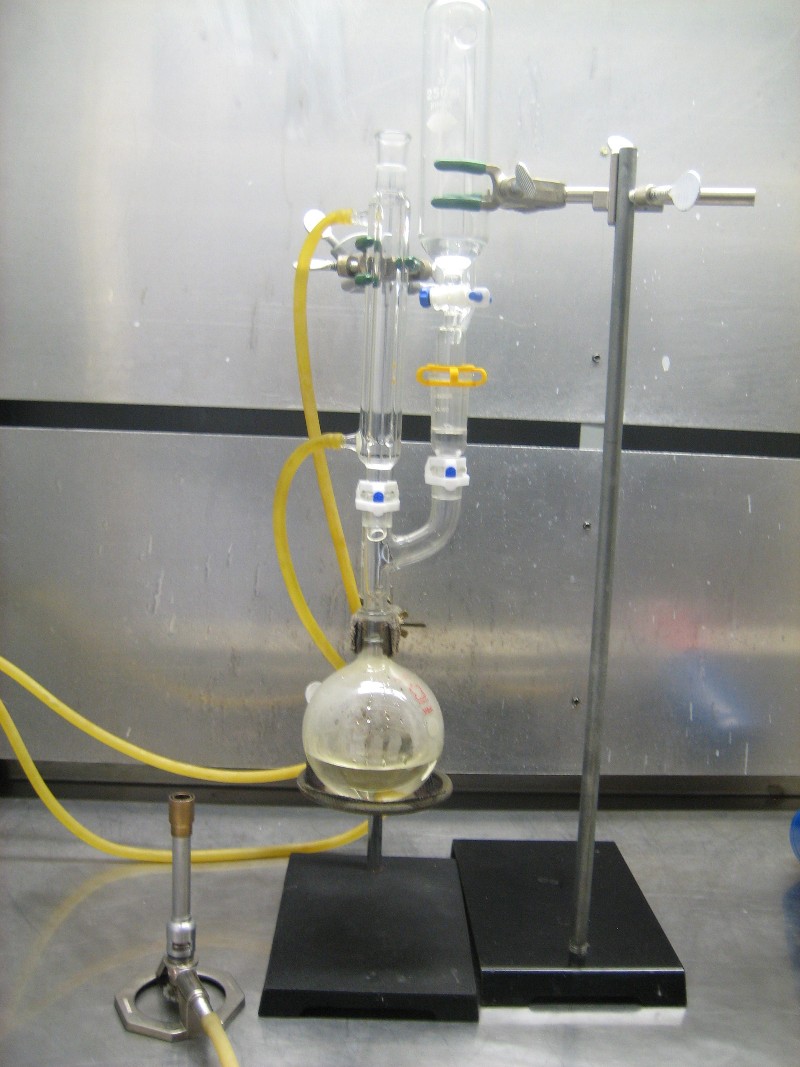 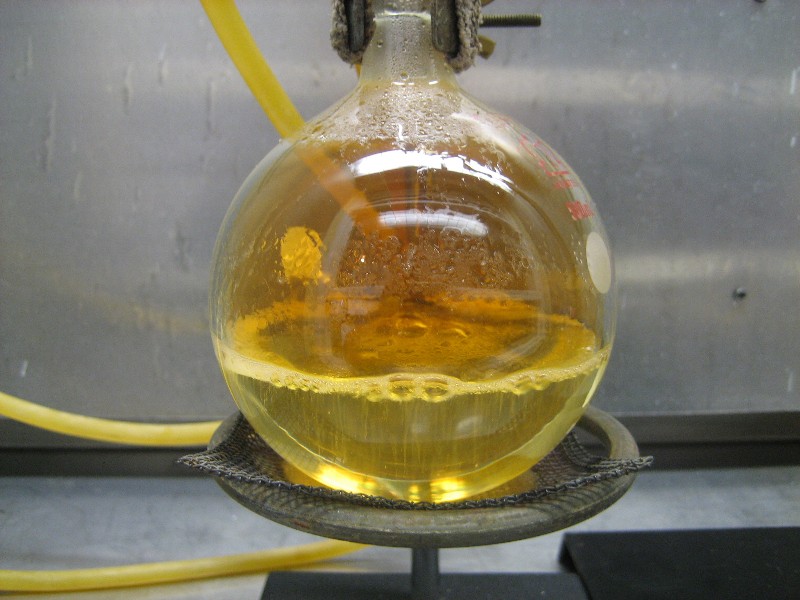 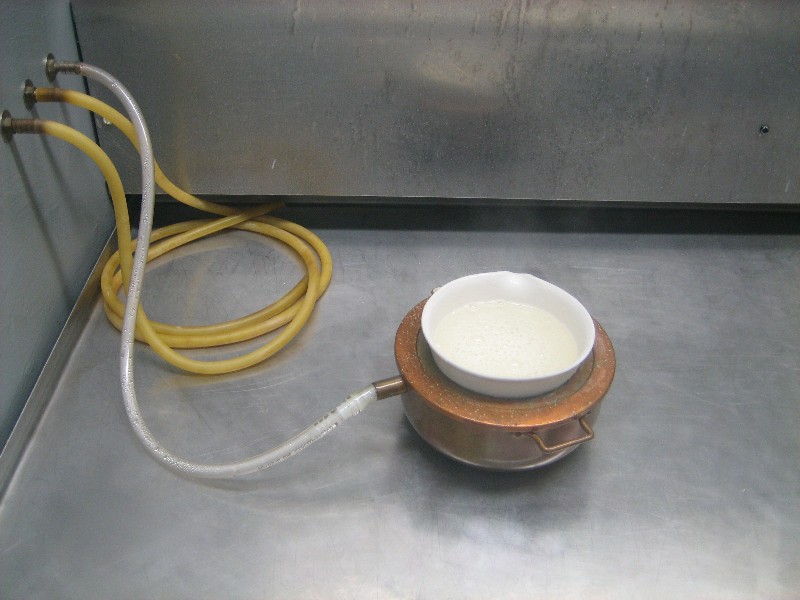 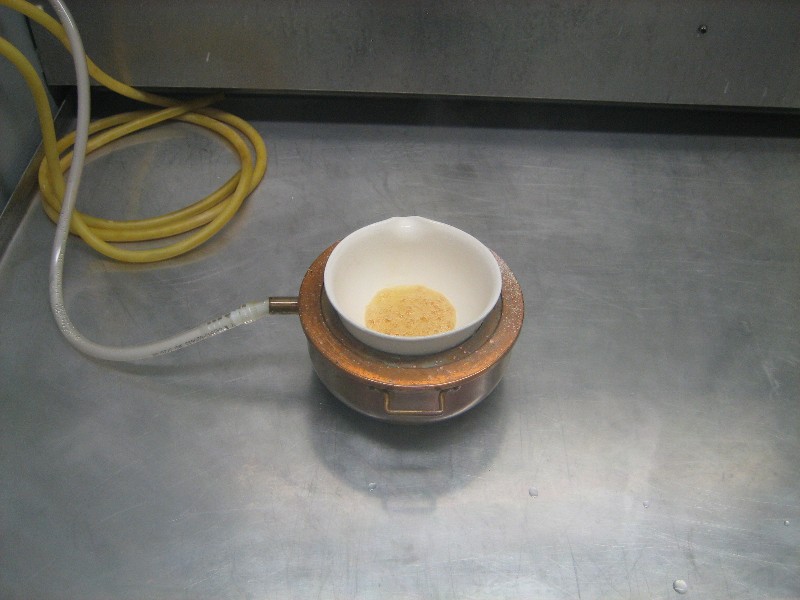 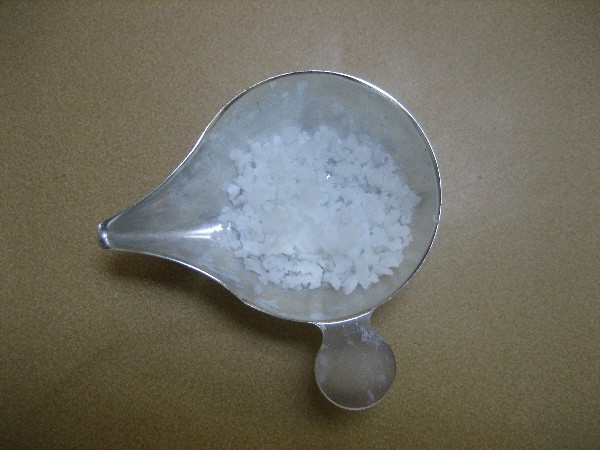
[Edited on 14-12-2009 by Magpie]
[Edited on 14-12-2009 by Magpie]
The single most important condition for a successful synthesis is good mixing - Nicodem
|
|
|
stateofhack
Hazard to Others
  
Posts: 123
Registered: 6-5-2008
Location: Warm Coast
Member Is Offline
Mood: annoyed
|
|
Very nice, thanks for this!
|
|
|
Jor
National Hazard
   
Posts: 950
Registered: 21-11-2007
Member Is Offline
Mood: No Mood
|
|
Very nice. But the problem is the 1,3-PDO. It is really expensive!
I see your azeotropic nitric is yellow. Clear it up with a little urea  . Just not
an excess so you have no dissolved urea (or is urea nitrate incredibly insoluble?). . Just not
an excess so you have no dissolved urea (or is urea nitrate incredibly insoluble?).
|
|
|
entropy51
Gone, but not forgotten
    
Posts: 1612
Registered: 30-5-2009
Member Is Offline
Mood: Fissile
|
|
OOH! You have steam on tap! How does that work?
|
|
|
Magpie
lab constructor
    
Posts: 5939
Registered: 1-11-2003
Location: USA
Member Is Offline
Mood: Chemistry: the subtle science.
|
|
>Stateofhack: Thank you.
>Jor: PDO expensive? I suppose it is if you buy reagent grade. If you buy industrial grade (for anti-freeze and airport de-icer) it could be
very reasonable. 
>entropy: Please see my steam generator below. I removed the cheap on-off temperature control from the hotplate. I replaced this with the Variac
control, which works beautifully.
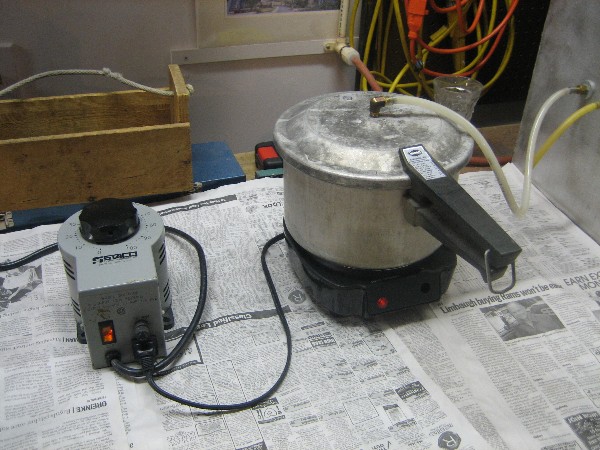
The single most important condition for a successful synthesis is good mixing - Nicodem
|
|
|
entropy51
Gone, but not forgotten
    
Posts: 1612
Registered: 30-5-2009
Member Is Offline
Mood: Fissile
|
|
Nice steam generator! Engineers rule!
|
|
|
Jor
National Hazard
   
Posts: 950
Registered: 21-11-2007
Member Is Offline
Mood: No Mood
|
|
Maybe you're right Magpie. Acros runs it for 120 EUR per liter   
i always though 1,3-propanediol is expensive, 1,2-propanediol is much cheaper IIRC.
But i checked another source wich sells parfumes, non-toxic solvents and chemicals, and lists propylene glycol. Now I found 250ml of the solvent for a
price of 4 EUR.
Might be interesting. I currently have about 30 grams of lab reagent malonic acid, but it might be interesting to make some more.
|
|
|
497
National Hazard
   
Posts: 778
Registered: 6-10-2007
Member Is Offline
Mood: HSbF6
|
|
| Quote: | | If you buy industrial grade (for anti-freeze and airport de-icer) it could be very reasonable. |
I have never seen (and cannot find upon searching) an antifreeze that contained 1,3-PDO. Always 1,2-PDO. So I am confused.
[Edited on 13-12-2009 by 497]
|
|
|
Magpie
lab constructor
    
Posts: 5939
Registered: 1-11-2003
Location: USA
Member Is Offline
Mood: Chemistry: the subtle science.
|
|
Quote: Originally posted by 497  |
I have never seen (and cannot find upon searching) an antifreeze that contained 1,3-PDO. |
They exist:
http://www.duponttateandlyle.com/products_susterra.html
But I don't know where they can be bought in a small quantity. I obtained mine from a private source.
The single most important condition for a successful synthesis is good mixing - Nicodem
|
|
|
DJF90
International Hazard
    
Posts: 2266
Registered: 15-12-2007
Location: At the bench
Member Is Offline
Mood: No Mood
|
|
Nice prep as with the other one on bromine. Was you following a literature procedure or was this self devised? Jor: I'm sure the dissolved nitrogen
oxides in the nitric acid will aid its oxidising ability, no?
|
|
|
Magpie
lab constructor
    
Posts: 5939
Registered: 1-11-2003
Location: USA
Member Is Offline
Mood: Chemistry: the subtle science.
|
|
This is self-devised in response to a vicious runaway experiended the first time I tried it.
Edit: Due credit must also be given to S.C.Wack:
Quote: Originally posted by S.C. Wack  | I'd guess that adding the nitric acid dropwise to hot glycol would be a better procedure than adding all of it and then heating.
|
The reference cited was also used to establish mole ratios, molarities, etc. Thanks go to entropy51 for that document.
[Edited on 13-12-2009 by Magpie]
The single most important condition for a successful synthesis is good mixing - Nicodem
|
|
|
pantone159
National Hazard
   
Posts: 586
Registered: 27-6-2006
Location: Austin, TX, USA
Member Is Online
Mood: desperate for shade
|
|
Nice, thanks for posting!
|
|
|
benzylchloride1
Hazard to Others
  
Posts: 299
Registered: 16-3-2007
Member Is Offline
Mood: Pushing the envelope of synthetic chemistry in one's basement
|
|
An extremely good method for producing malonic acid, thank you very much for posting this. I have read that methylene magnesium bromide can be reacted
with carbon dioxide to produce malonic acid. Methylene magnesium bromide is a Grignard Reagent that can be produced by reacting methylene bromide with
magnesium activated with mercuric chloride in ether, see either Fiesers Reagents for Organic Synthesis, volume 2 or 3. Methylene magnesium chloride
may be able to be produced from methylene chloride by reacting it with activated magnesium, or methylene bromide may be able to be produced from the
Finkelstein Reaction of methylene chloride with sodium bromide in a suitable solvent. This may make the large scale synthesis of malonic aicd possible
from easy to find chemicals. My only worry is that alkyl mercury compounds may be produced.
[Edited on 14-12-2009 by benzylchloride1]
Amateur NMR spectroscopist
|
|
|
Magpie
lab constructor
    
Posts: 5939
Registered: 1-11-2003
Location: USA
Member Is Offline
Mood: Chemistry: the subtle science.
|
|
Thank you pantone and benzylchloride.
I had never thought of using a Grignard reagent for producing a dicarboxylic acid - very interesting.
The single most important condition for a successful synthesis is good mixing - Nicodem
|
|
|
Jor
National Hazard
   
Posts: 950
Registered: 21-11-2007
Member Is Offline
Mood: No Mood
|
|
Isn't it possible to activate the magnesium with iodine or 1,2-dibromoethane?
Otherwise use an extremely small amount of mercuric chloride!
Are you sure you can also do the Finkelstein reaction to exchange chlorine for bromine? Isn't NaBr also quite insoluble in acetone?
However, I guess methylene iodide would also work.
|
|
|